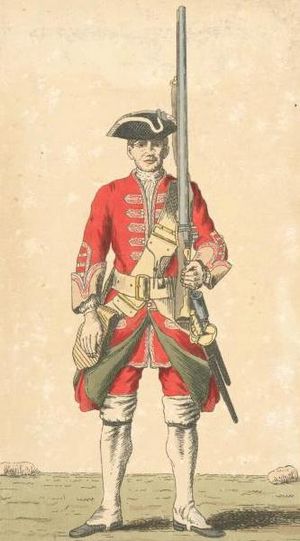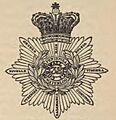32nd (Cornwall) Regiment of Foot facts for kids
Quick facts for kids 32nd (Cornwall) Regiment of Foot |
|
|---|---|

Badge of the 32nd (Cornwall) Regiment of Foot
|
|
| Active | 1702–1881 |
| Country |
|
| Branch | |
| Garrison/HQ | Victoria Barracks, Bodmin |
| March | One and All |
| Engagements | War of the Spanish Succession War of the Austrian Succession Napoleonic Wars Lower Canada Rebellion Second Anglo-Sikh War Indian Rebellion |
| Battle honours | Gibraltar 1705 |
The 32nd Regiment of Foot was a famous infantry (foot soldier) group in the British Army. It started in 1702. This regiment was known for its bravery and service.
Later, in 1881, it joined with another group. This was part of big changes called the Childers Reforms. The 32nd Regiment combined with the 46th (South Devonshire) Regiment of Foot. Together, they formed a new unit called the Duke of Cornwall's Light Infantry.
Contents
History of the 32nd Regiment
Early Battles and Changes
The 32nd Regiment began in 1702. It was first called Edward Fox’s Regiment of Marines. They were formed to fight in the War of the Spanish Succession. Some soldiers from the regiment joined a fleet of ships. They fought as marines at the Battle of Vigo Bay in October 1702.
The marines then returned to England. The regiment also helped capture and defend Gibraltar in 1704. They faced heavy losses at the Battle of Almansa in 1707. The regiment was stopped in 1713. But it started again in 1714 as Jacob Borr’s Regiment of Foot. They served in Ireland for many years.
In 1742, the regiment went to Belgium. They fought in the War of the Austrian Succession. They were kept in reserve at the Battle of Dettingen in 1743. But they fought bravely at the Battle of Fontenoy in 1745. The regiment came back to England in October 1745. They were in Lancashire during the Jacobite rising.
In 1751, a royal order changed how regiments were named. They would no longer be known by their colonel's name. Instead, they would use a number. So, General Francis Leighton's Regiment became the 32nd Regiment of Foot.
In 1775, a ship carrying soldiers and their families sank. It was called the Rockingham Castle. About ninety people, including soldiers, drowned in a storm. In 1782, the regiment got a county name. It became the 32nd (Cornwall) Regiment of Foot. This honored the county of Cornwall.
In 1796, the regiment went to Saint-Domingue. They were there to help with a rebellion. But a French ship captured one of their transport ships. Some soldiers became prisoners of war. The regiment also went to Dublin in 1803. They helped during the Irish rebellion.
Fighting in the Napoleonic Wars

In July 1807, the regiment went to Denmark. They served as marines on captured Danish ships. This happened during the Battle of Copenhagen. It was part of the Gunboat War.
The regiment arrived in Portugal in June 1808. They fought under General Sir Arthur Wellesley. They took part in the Battle of Roliça and the Battle of Vimeiro in August 1808. The regiment then retreated to Corunna with General Sir John Moore.
After returning to England, they joined the Walcheren Campaign. Many soldiers got sick with malaria there. After getting more soldiers, they went back to Spain in 1811. They helped attack during the Battle of Salamanca in July 1812. The regiment chased the French Army into France. They fought in the Battle of the Pyrenees in 1813. They also fought at the Battle of Nivelle and the Battle of the Nive in 1813. Their last big battle was the Battle of Orthez in 1814.
During the Napoleonic Wars, their uniforms had white facings. Officers wore gold lace and buttons. The regiment fought bravely at the Battle of Quatre Bras. They arrived just in time to stop the French advance. Two days later, they fought at Battle of Waterloo. The regiment stood firm against Napoleon's attacking troops. They were commanded by Lieutenant-Colonel John Hicks. Two of their soldiers carried General Picton's body after he was shot.
The Victorian Era and Beyond
In June 1830, the regiment went to Canada. They fought in the Battle of Saint-Denis in 1837. They also fought at the Battle of Saint-Eustache in 1837. These battles were part of the Lower Canada Rebellion. The regiment also saw action in India. They fought at the Siege of Multan in 1848. They were also at the Battle of Gujrat in 1849. These were during the Second Anglo-Sikh War.
The regiment famously defended Lucknow from July to November 1857. This was during the Indian Rebellion. Several soldiers received the Victoria Cross for their bravery. These included William Dowling, Henry Gore-Browne, Samuel Lawrence, and William Oxenham. The regiment's commander, Colonel John Inglis, led the defense of Lucknow. Because of their courage, the regiment was renamed. It became the 32nd (Cornwall) Regiment of Foot (Light Infantry).
In the 1870s, changes called the Cardwell Reforms happened. Single regiments were linked together. The 32nd was linked with the 46th (South Devonshire) Regiment of Foot. They shared a training base in Bodmin, Cornwall. On July 1, 1881, the Childers Reforms took effect. The 32nd Regiment joined with the 46th Regiment. They formed the Duke of Cornwall's Light Infantry. The old flags of the 32nd Regiment are kept at St. Petroc's Church in Bodmin.
Battle Honours
Battle honours are special awards given to regiments for their bravery in battles. The 32nd Regiment earned many:
- Peninsular War: Roliça, Vimiera, Corunna, Salamanca, Pyrenees, Nivelle, Nive, Orthes, Peninsula
- Waterloo
- Second Anglo-Sikh War: Goojerat, Mooltan, Punjaub
- Indian Mutiny: Lucknow
- Dettingen (awarded to successor regiment, 1882)
- Gibraltar 1704–05 (awarded to successor regiment, 1909)
Victoria Crosses
The Victoria Cross is the highest award for bravery in the British military. These soldiers from the 32nd Regiment received it:
- Private William Dowling, for actions during the Indian Mutiny (July 4, 1857 and September 27, 1857)
- Captain Henry Gore-Browne, for actions during the Indian Mutiny (August 21, 1857)
- Lieutenant Samuel Lawrence, for actions during the Indian Mutiny (July 7, 1857 and September 26, 1857)
- Corporal William Oxenham, for actions during the Indian Mutiny (June 30, 1857)
Images for kids







